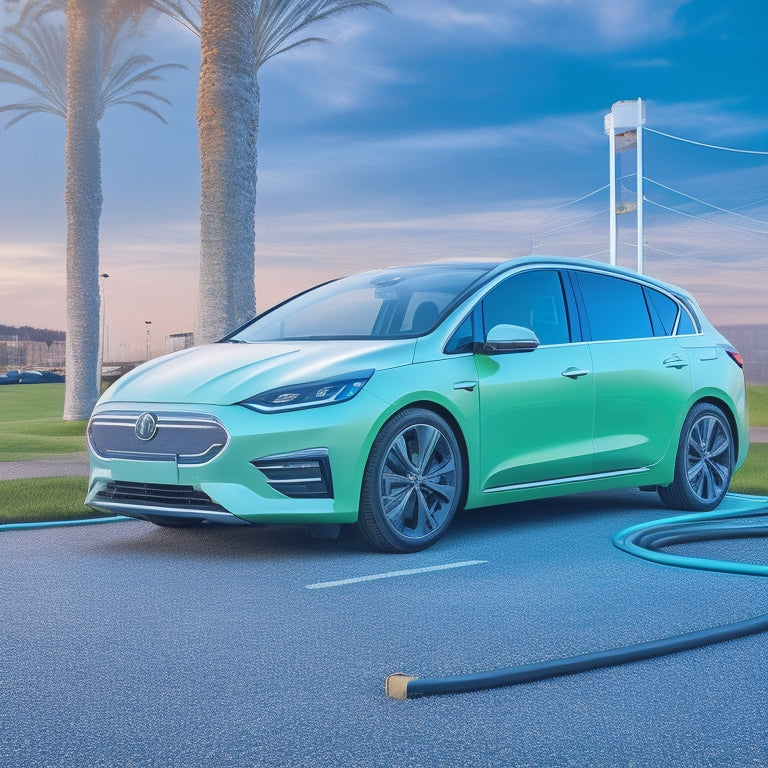
Electric Vehicle Tax Credits: What You Need
Share
Understanding the eligibility requirements and phaseout rules is crucial for maximizing the benefit of the federal government's tax credit of up to $7,500, which aims to encourage the adoption of environmentally friendly electric vehicles. Buyers must meet specific criteria, such as minimum battery capacity and North American assembly, and obtain a time-of-sale report to claim the credit. Factors like income thresholds and manufacturer sales can impact the credit amount, which varies depending on the vehicle's specifications. By delving into the details, you can navigate the process effectively and make well-informed purchasing decisions.
Key Takeaways
• The federal tax credit offers up to $7,500 benefit for eligible electric vehicle purchases in 2023 or later, encouraging eco-friendly transportation.
• Eligible vehicles include all-electric, plug-in hybrid, and fuel cell electric vehicles that meet manufacturer qualifications and minimum battery capacity thresholds.
• To claim the credit, buyers must determine eligibility at the time of sale, obtain a time-of-sale report, and file Form 8936 with their tax return.
• The credit amount varies by vehicle, with higher battery capacities and weight ratings qualifying for higher credits, up to a maximum of $7,500.
• The credit phases out after a manufacturer sells 200,000 qualifying vehicles, with a one-year phaseout period before the credit amount is reduced to $0.
Federal Tax Credit Overview
The federal tax credit for electric vehicles serves as an essential incentive for environmentally conscious consumers. It offers a significant financial benefit of up to $7,500 for eligible purchases made in 2023 or later. This tax credit is designed to encourage the adoption of eco-friendly transportation, making electric vehicles more accessible to a broader audience.
To take advantage of this incentive, consumers must navigate the tax credit application process, ensuring they meet the necessary eligibility criteria. Eligible vehicles, including all-electric, plug-in hybrid, and fuel cell electric vehicles, can be searched based on the placed-in-service date, with updated information provided by the IRS.
Vehicle Eligibility Requirements
What distinguishes an eligible vehicle from an ineligible one, and what specific criteria must be met to qualify for the federal tax credit?
To qualify, vehicles must meet manufacturer qualifications, battery capacity restrictions, and other criteria. The vehicle's battery capacity must meet a minimum threshold, and the manufacturer must meet specific requirements, such as assembly location in North America. Additionally, the vehicle's weight rating and other specifications are also considered.
Sellers must report necessary information to buyers and the IRS at the time of sale, and dealers must register with the IRS Energy Credits Online.
Claiming the Electric Vehicle Credit
To claim the electric vehicle credit, buyers must follow specific procedures, which vary depending on the vehicle's placement in service before or after January 1, 2024.
For vehicles placed in service before 2024, buyers must file Form 8936 with their tax return. Starting January 1, 2024, credit eligibility will be determined at the time of sale using the IRS Energy Credits Online website. Buyers will receive a copy of the time-of-sale report for credit claiming purposes.
Here are the key steps to claim the electric vehicle credit:
-
Determine eligibility: Verify the vehicle's eligibility for the credit at the time of sale.
-
Obtain time-of-sale report: Get a copy of the report from the dealer, which is required for credit claiming.
-
Claim the credit: File Form 8936 with your tax return or opt for credit transfer to the dealer.
Vehicle Types and Credit Amounts
Electric vehicles eligible for federal tax credits encompass a range of vehicle types, each with its corresponding credit amount, which is determined by factors such as battery capacity, weight rating, and manufacturer.
The credit amount varies depending on the vehicle's specifications, with a maximum credit of up to $7,500 for qualified vehicles. Manufacturer qualifications, credit limits, and battery capacity play significant roles in determining the credit amount.
For instance, vehicles with higher battery capacities and weight ratings typically qualify for higher credit amounts. Additionally, manufacturer-specific requirements, such as assembly location and battery component sourcing, also influence the credit amount.
Understanding these factors is essential for buyers to determine the applicable credit amount for their chosen vehicle.
Tax Credit Limitations and Phaseout
The federal tax credit for electric vehicles is subject to certain limitations and phaseout provisions, which are triggered when a manufacturer reaches a cumulative sales threshold of 200,000 qualifying vehicles in the United States. This phaseout process is designed to gradually reduce the credit amount available to buyers.
Here are the key aspects of the credit phaseout:
- Phaseout trigger: The credit phaseout begins when a manufacturer reaches 200,000 qualifying vehicles sold in the United States.
- Credit reduction: The credit amount is reduced by 50% for the first 6 months after the phaseout trigger, and then reduced by 75% for the subsequent 6 months.
- Final phaseout: After the 1-year phaseout period, the credit amount is reduced to $0.
It is essential to take into account these limitations and phaseout provisions when planning to purchase an electric vehicle, as they can have a significant impact on the credit amount available.
Additionally, income thresholds may also affect the credit eligibility.
Reporting and Approval Process
As the clean vehicle credit landscape evolves, a streamlined reporting and approval process becomes essential for guaranteeing that eligible buyers can claim their credits efficiently.
Starting January 1, 2024, dealers must report necessary information to buyers and the IRS at the time of sale, facilitating a seamless credit approval process. This time of sale reporting enables the IRS to verify credit eligibility, ensuring buyers receive their deserved incentives.
The credit approval process involves dealers submitting a time-of-sale report to the IRS, which buyers will receive a copy of for claiming purposes.
A well-structured reporting and approval process minimizes delays and ensures a smooth experience for eligible buyers.
Additional Resources and Guidance
Beyond the federal tax credits, various resources and guidance are available to help individuals and businesses navigate the complex landscape of clean vehicle incentives. To guarantee a smooth process, it is crucial to stay informed about the latest developments and requirements.
For further guidance, refer to the following resources:
-
IRS FAQs: Detailed information on new, previously-owned, and qualified commercial clean vehicle credits.
-
26 CFR Parts 1 and 301: Regulations outlining clean vehicle credits, credit transfer, critical minerals, and battery components.
-
FuelEconomy.gov Tax Incentive Data Services: Information on tax credits for electric vehicles and charging infrastructure, including qualification criteria and credit transfer processes.
These resources provide valuable insights into the qualification criteria, credit transfer, and other essential aspects of electric vehicle tax credits.
Frequently Asked Questions
Can I Claim the Credit if I Lease an Eligible Electric Vehicle?
When leasing an eligible electric vehicle, the lessor, not the lessee, claims the federal tax credit, passing benefits to the lessee through lower lease payments over the lease duration, maximizing leasing benefits.
Are There Tax Credits Available for Electric Motorcycles or Scooters?
As eco-friendly enthusiasts hit the open road, they wonder: are there tax credits available for electric motorcycles or scooters? Yes, road-ready riders can rev up their savings with a 10% tax credit, up to $2,500, for qualified electric two-wheelers purchased in or after 2023.
Can I Claim the Credit if I Buy an Electric Vehicle for Business Use Only?
For business-use electric vehicles, claim the credit as a business expense, following depreciation rules, and consult IRS guidelines to guarantee proper reporting and compliance, maximizing your credit eligibility.
Is the Tax Credit Available for Electric Vehicles Purchased Outside the Us?
The tax credit for electric vehicles is only applicable to vehicles assembled in North America, adhering to import rules, with battery components sourced domestically; foreign-sourced vehicles do not qualify for the credit.
Can I Transfer the Tax Credit to a Subsequent Owner or Sell It?
"A treasure trove of tax benefits awaits! Regarding credit transfer, the answer is a resounding no - the credit is non-transferable, and buyers cannot assign or sell it to subsequent owners, as it's tied to the original purchaser's tax liability."
Related Posts
-

7 Best Home Hydrogen Fuel Cells for Clean Power
You're considering adopting hydrogen fuel cells for clean power at home, but you want to know the best options. Reput...
-

10 Best Energy-Efficient External Hard Drives for Sustainable Offices
When it comes to sustainable offices, you need external hard drives that balance data storage needs with energy effic...
-

7 Smart Air Purification Hacks for Energy-Savvy Homes
You can notably improve your indoor air quality while minimizing energy consumption by implementing strategic air pur...


